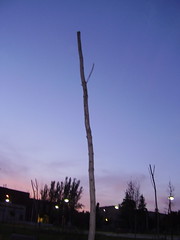spaces acquiring stories and a short exercise in terror
"Traditions and Cultures at IU" incorporates many of the things we have been talking about in class this semester quite gracefully. And as with all things that are graceful, it appears almost effortless. First of all, it is surprisingly easy on the eyes. This seems simple enough, but we have seen how websites that are too busy are difficult to follow and therefore interfere with viewer engagement. Good design equals better navigation and ultimately better learning.
The sections are made up 15 to 30 slides with images that are accompanied by a short paragraph. Where appropriate, the slides are also accompanied with audio clips. For example, one of the slides about Hoagy Carmichael has links to three of his songs. This is a way to incorporate primary source material that seems quite natural and organic (as opposed to having it be a separate section that seems contrived). The slides are framed by an introductory audio clip and a quiz.
What I like about the site is that, while it is easy to follow, it is not necessarily linear. The sections are grouped according to chronology but also according to themes. Having the content of the entire course available to you as soon as you log into the site gives you a certain amount of room to wander; the great thing about having a class on a space that students also roam in their daily lives is that the buildings they enter physically literally acquire a story as the semester progresses. History is not something that happened long ago in a place far away, but something that they, too, participate in.
The Wikipedia exercise was harder than I had thought. I had planned on entering my own research on the Salvadoran novelist Maria Alvarez all week, only to find that Wikipedia strongly discourages original research. The "encyclopedia" mode of writing is also surprisingly alien to me: what, no argument? The guidelines that the administrators have regarding "neutrality" struck me as particularly old fashioned. So I though I would enter some interesting things, or "facts" that I found about the Cathedral of San Salvador during my research, but once I was about to edit an existing page with a few pages of information, I suddenly had a terrifying thought. What if I try to publish my work on the cathedral in the future and someone thinks that I copied it, word for word, from Wikipedia? Paranoid, yes, but plausible enough. So finally I figured that the only appropriate sort of thing to publish on Wikipedia would be a short article about a fantastic museum of history in El Salvador that usually falls under the radar of tourists because it tends to not be affiliated with the department of Tourism precisely because they are engaging with memories that are difficult and controversial (the civil war, the massacre of 1932). I am still working on that entry, but will have it up this weekend. I just never thought it would be so difficult to get out of the "original research" frame of mind.

